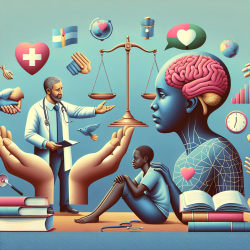Understanding Homosexuality: A Shift from Pathology to Acceptance
As a practitioner in the field of speech-language pathology, understanding the historical and scientific context of homosexuality can significantly enhance your ability to create inclusive and supportive environments for children. The research article "Out of DSM: Depathologizing Homosexuality" by Jack Drescher provides a comprehensive overview of the journey from viewing homosexuality as a mental disorder to recognizing it as a natural variation of human sexuality.
The Historical Context
In 1973, the American Psychiatric Association (APA) made a groundbreaking decision to remove "homosexuality" from the Diagnostic and Statistical Manual of Mental Disorders (DSM). This decision was not made lightly; it was the result of comparing theories that pathologized homosexuality with those that viewed it as a normal variation. Understanding this shift is crucial for practitioners who aim to provide data-driven, inclusive care.
Key Theories of Homosexuality
The research identifies three broad categories of theories regarding homosexuality:
- Theories of Pathology: These theories regarded homosexuality as a disease or a deviation from "normal" heterosexual development. Such views often linked homosexuality to internal defects or external pathogenic agents.
- Theories of Immaturity: These theories, often psychoanalytic, viewed homosexuality as a phase of immaturity that one should outgrow, equating adult homosexuality with stunted growth.
- Theories of Normal Variation: These theories recognize homosexuality as a natural variation, akin to left-handedness, and argue that it should not be included in psychiatric diagnostic manuals.
Implications for Practitioners
For practitioners, understanding these theories and the historical context is vital. It encourages a shift from questioning the causes of homosexuality to focusing on the health and mental health needs of LGBT populations. Here are some practical steps to enhance your practice:
- Educate Yourself: Familiarize yourself with the historical context and current understanding of homosexuality as a natural variation.
- Promote Inclusivity: Create an inclusive environment that respects and supports diverse sexual orientations.
- Advocate for Change: Use your understanding to advocate for policies and practices that support LGBT individuals and challenge discriminatory practices.
- Engage in Continuous Learning: Stay updated with the latest research and developments in the field to ensure your practice remains inclusive and effective.
Encouraging Further Research
Practitioners are encouraged to delve deeper into this topic to better understand the complexities of human sexuality and its implications for therapy. By doing so, you can contribute to a more inclusive and supportive environment for all individuals, regardless of their sexual orientation.
To read the original research paper, please follow this link: Out of DSM: Depathologizing Homosexuality.










